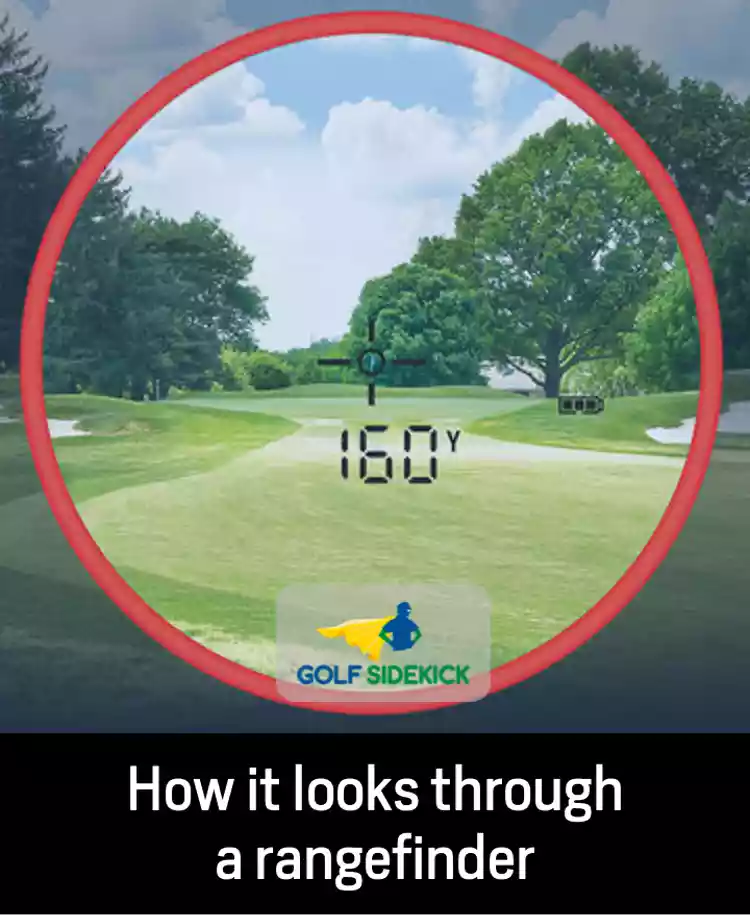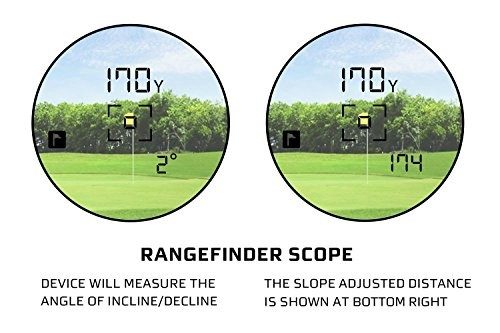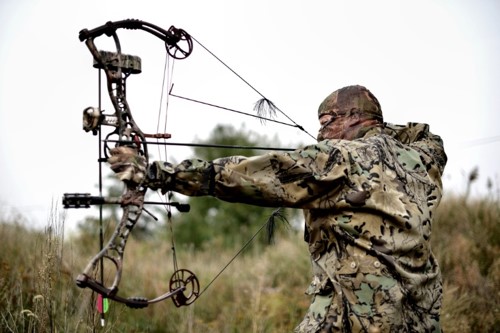Last Updated on December 26, 2023 by Matt Greene
Golf rangefinders are a super useful tool for golfers of all levels. Quite simply, they remove the guesswork from calculating yardages on the golf course, giving you highly accurate distances to the flag or hazards in front of you.
But do you know how to use a golf rangefinder? Thankfully it's a lot easier to use a golf rangefinder than actually playing golf! In this article we're going to cover all of the biggest questions around how to use a golf rangefinder. We'll look at how to aim your rangefinder, right through to understanding the technology behind laser rangefinders and how the slope setting works.
How does a golf rangefinder work?
A Laser Rangefinder uses a laser beam aimed at the target to work out its distance. A laser is beamed to the target, like the pin, and reflects back to the rangefinder. The time that it took the laser to reflect back to the device is used to calculate the distance.
Some laser rangefinders feature an internal ‘inclinometer’ which can factor in the slope of your target area. Slope is determined by the distance from level the reflection is upon returning to the device. Another feature some have is a ‘PinSeeker’ ability which allows the device to focus on the pin and not background objects. To help golfers targeting with a rangefinder many are equipped with up to five times magnification lenses to give you a really crisp view of what you're aiming at.
The big advantage of having a rangefinder is its flexibility and ability to allow you to pin point any object on the course and work out how far away it is. No more downloading course maps to your watch and waiting to acquire a good GPS signal. You simply point and shoot, no hanging around.
Laser rangefinders in my experience tend to be slightly more accurate than a GPS rangefinder as you're not relying on a satellite in space to give you a distance. I find the best of both worlds is to use a laser rangefinder and a GPS watch to get all the information you need, like front, middle and back distances to the green and then very specific yardages to the flagstick.
How to use a golf rangefinder monocular
If you've ever seen a golf rangefinder before, you might have noticed that golfer's use it with just one eye. This is called a monocular rangefinder, and all rangefinders are configured in this way.
Using a rangefinder is a really simple operation, all you need to be able to do is keep you non viewing eye closed and then have steady enough hands to operate the controls on the rangefinder unit and keep it on target.

Where to aim a golf rangefinder
When using a rangefinder on the golf course, you're going to be trying to get a distance reading to the pin on the green, a hazard or another point on the course to set up a specific yardage.
All good quality optical rangefinders designed to be used for golf will be able to pick out a target object with ease. To get a good lock on your target, its best to aim the rangefinder at the biggest part of the object. So if you're aiming for a flagstick, aim at the flag and if you're trying to work out how far that water hazard is, aim at one of the red stakes marking where the hazard starts.
On many golf courses you will now see that flagsticks have special material attached to them with a reflective surface which makes it much easier for the laser rangefinder to acquire the target.
If you are having trouble getting and accurate reading, there are a few things too look out for.
- Objects in the foreground - If there are branches, leaves or other parts of the golf hole even slightly obscuring the flag or other target, there's a chance your range finder might pick up the wrong thing. Usually it's pretty obvious as the reading you'll get will seem odd, so make sure to take a couple of measurements or cross check against a GPS app or distance markers to make sure you're in the right ball park.
- Colour and size of the flag - I might be totally wrong here, but I swear that rangefinders struggle to pick up certain colors, blue being the worst in my experience. I'm sure there will be people reading this saying I'm crazy, but whenever I play a course with white or yellow flags I never seem to have an issue getting the exact distance I need. I also found that in flat calm conditions with no wind, it's very hard to get a good reading as the laser beam doesn't have a big enough target to aim at.
- Check your battery - Most rangefinders use CR2 batteries. They have a pretty decent lifespan if you buy from a quality brand, but I have found that if my battery is low on juice, my rangefinder will struggle measuring distances and getting a solid lock on the target. If you have a more modern gps golf rangefinder, you will find that your battery will get drained really fast, so always carry a spare with you. Precision Pro offer free battery replacements for their products and I've personally used this service and it's pretty cool to get free batteries sent through when you need them.
How to hold a rangefinder steady
Not all of us have the steadiest of hands, and when you're faced with a clutch shot out the golf course, you might find it hard to get a lock onto the flagstick or target.
Most modern rangefinders will work even if you swaying about a bit, but I've found a few things help to keep your aim locked on.
- Use one hand to hold the rangefinder and rest your elbow on your chest. This will prevent your arm from shaking.
- If you're riding in a golf buggy, use the frame of the cart to steady yourself. If you can fold the windshield down, you can rest the rangefinder on-top of the bottom half, giving you a solid base.
- If you have a willing playing partner, you can use their shoulder as a rest. Just ask them first!
Good quality rangefinders will have a target lock feature, essentially the rangefinder will buzz when it's acquired the target. Use this to make sure you're firing the laser at the right thing on the golf course.
What is slope mode on a rangefinder?
Slope mode on a golf rangefinder is a super cool feature and should improve your golf game. Slope basically means that the rangefinder will give you a distance which takes into account how much yardage the terrain in front of you will add or take away from the distance between you and the target.
For example, if the flag is on a slope above you, you will have to hit the ball further as the incline will stop the flight of the ball prematurely. So a shot which on paper is 165 yards could actually be 175 yards depending on the severity of the slope.

How to use slope on a rangefinder
Slope mode is by default switched off on a rangefinder and not all golf rangefinders have a slope mode. The reason slope mode has to be enabled is that it is not legal for tournament play. If you're playing golf casually then you can have slop engaged.
Depending on the model of your golf rangefinder, slope is usually switched on by pressing a button on the case of the unit. On my Precision Pro rangefinder, this is done by pressing the "Mode" button once. I know I have slope on as the display of the rangefinder shows "M2" or mode 2, which means the feature has been enabled.
To switch slope mode off, simply press the mode button again. It's that easy.
A handy feature of most rangefinders with slope is that it will show you two yardages, one with and one without slope. This is good as it trains your eye to understand how inclines and declines on the golf course will affect your yardages. Then when you have to switch slope off for a tournament, you will be better equipped to adjust your game to what is in front of you.
Amateur golfers should benefit from this feature as it will reduce the chances of poor club selection. Many golfers calculate the distance to the flag by looking at on course yardage markers or with a golf gps watch or app. This will only give you part of the story and an optical rangefinder with slope is well worth having.
Are slope rangefinders legal?
Yes slope rangefinders are legal - BUT you cannot use the slope feature for tournament play. Most golf courses won't check, but you could be asked to prove you have the slope function off if you play in an open at a golf course you're not a member at for example.

Hunting rangefinder vs golf rangefinders
Hunting rangefinders and golf rangefinders are not the same! They may look similar and even be made by the same manufacturers, but do not bee fooled.
Hunting rangefinders make use of “Distant Target Mode” that focuses on targets in the wilderness, not the foreground like a golf rangefinder.
Hunting rangefinders are more precise than golf rangefinders but you may have to compromise on speed since they tend to be a little slower. They also differ in terms of range. Most golf laser rangefinders cover up to 400 yards. Some may offer more coverage but that comes at a cost – less accuracy. Hunting rangefinders easily cover 1,000 yards but they can’t tell you exactly where the flag is.
Final thoughts on how to use a golf rangefinder
I firmly believe that all golfers should use a golf rangefinder. They feature extensively on my YouTube channel and are a key tool for golfers trying to break 100, 90 and 80. Why wouldn't you use all of the tools at your disposal to get the job done and lower your scores. Check out my reviews and buying guides to find the best rangefinder for your needs and budget.
